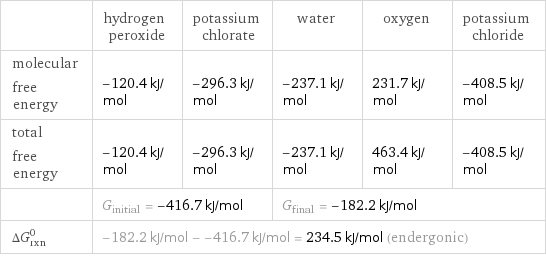Input interpretation

hydrogen peroxide + potassium chlorate ⟶ water + oxygen + potassium chloride
Balanced equation

Balance the chemical equation algebraically: + ⟶ + + Add stoichiometric coefficients, c_i, to the reactants and products: c_1 + c_2 ⟶ c_3 + c_4 + c_5 Set the number of atoms in the reactants equal to the number of atoms in the products for H, O, Cl and K: H: | 2 c_1 = 2 c_3 O: | 2 c_1 + 3 c_2 = c_3 + 2 c_4 Cl: | c_2 = c_5 K: | c_2 = c_5 Since the coefficients are relative quantities and underdetermined, choose a coefficient to set arbitrarily. To keep the coefficients small, the arbitrary value is ordinarily one. For instance, set c_1 = 1 and solve the system of equations for the remaining coefficients: c_1 = 1 c_3 = 1 c_4 = (3 c_2)/2 + 1/2 c_5 = c_2 The resulting system of equations is still underdetermined, so an additional coefficient must be set arbitrarily. Set c_2 = 1 and solve for the remaining coefficients: c_1 = 1 c_2 = 1 c_3 = 1 c_4 = 2 c_5 = 1 Substitute the coefficients into the chemical reaction to obtain the balanced equation: Answer: | | + ⟶ + 2 +
Structures

+ ⟶ + +
Names

hydrogen peroxide + potassium chlorate ⟶ water + oxygen + potassium chloride
Reaction thermodynamics
Gibbs free energy

| hydrogen peroxide | potassium chlorate | water | oxygen | potassium chloride molecular free energy | -120.4 kJ/mol | -296.3 kJ/mol | -237.1 kJ/mol | 231.7 kJ/mol | -408.5 kJ/mol total free energy | -120.4 kJ/mol | -296.3 kJ/mol | -237.1 kJ/mol | 463.4 kJ/mol | -408.5 kJ/mol | G_initial = -416.7 kJ/mol | | G_final = -182.2 kJ/mol | | ΔG_rxn^0 | -182.2 kJ/mol - -416.7 kJ/mol = 234.5 kJ/mol (endergonic) | | | |
Chemical names and formulas

| hydrogen peroxide | potassium chlorate | water | oxygen | potassium chloride Hill formula | H_2O_2 | ClKO_3 | H_2O | O_2 | ClK name | hydrogen peroxide | potassium chlorate | water | oxygen | potassium chloride IUPAC name | hydrogen peroxide | potassium chlorate | water | molecular oxygen | potassium chloride